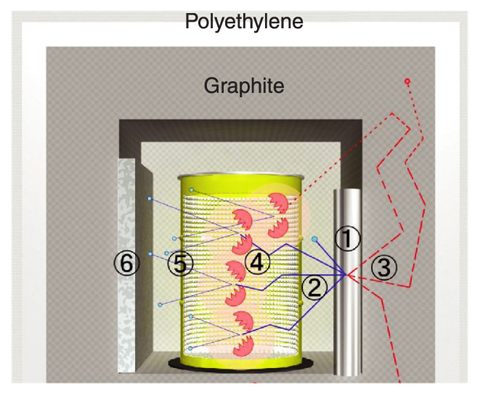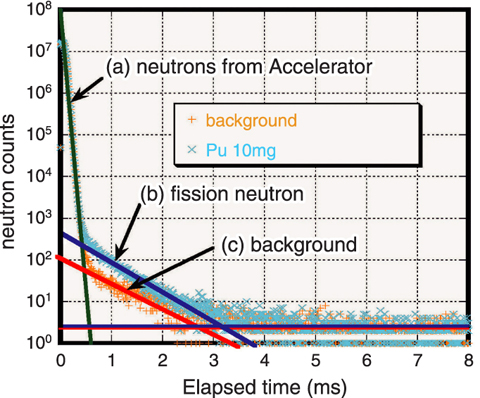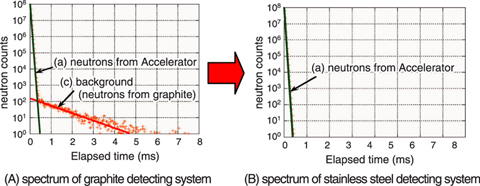
Fig.10-3 Concept of measurement

Fig.10-4 Measurement spectrum

Fig.10-5 Improvement of background
The 14MeV neutron direct interrogation method detects neutrons generated by nuclear fissions of the fissile material in nuclear waste which are induced by irradiation with neutrons from outside. This method has the advantage that it can detect a trace amount of the fissile material in a short time with position-independent sensitivity.
As is schematically shown in Fig.10-3, the gist of this method is to measure the nuclear fission neutrons generated by the interrogation neutrons.
First of all, the 14MeV interrogation neutrons from the generator tube are slowed down to thermal neutrons by the moderation effect of the measurement system and the materials themselves. These thermal neutrons induce nuclear fissions and generate the nu-clear fission neutrons effectively.
Next, in order for the He-3 detector to detect only the fast neutrons selectively, we use a detector bank that is surrounded with a cadmium sheath. The thermal neutrons cannot reach the detectors because of cadmium shield, and only the fast neutrons (14MeV neutrons and nuclear fission neutron) are detected.
Then, the nuclear fission neutron can be identified by sorting the time distribution of detected neutron data. The time spectra in Fig.10-4 were measured with this detector system, both when the nuclear material was present and was not present. The target of the measurement is the nuclear fission neutrons, component (b), and the background count, component (c).
A troublesome characteristic of the background neutron is that it is not easy to discriminate it from a nu-clear fission neutron. Because the spectrum (b) and (c) have a similar time inclination, the component (c) and the component (b) cannot be separated. Therefore, the detection limit of nuclear fission neutron component (b) is decided by the deviation of the back ground (c). Thus, we realized that great improvement of the detection accuracy requires elimination of background (c).
Research using computation simulation shows that the detection limit can be improved by 2 digits. The background (c) disappears as shown in Fig.10-5, if the moderator (reflection material) is changed from graphite to stainless steel.
This will enable us to perform clearance measurement of uranium waste, and to determine if there is transuranic contamination. As a result, reduction of the disposal cost of waste is expected.
It is an important task to secure safety when disposing of nuclear waste, and to suppress the cost. We wish that our research will help bring about the security and lowered cost of waste disposal.
<Previous: 10 Collaboration on Basic Nuclear Engineering | Next: 11 Photo-Medical Research Cooperation >